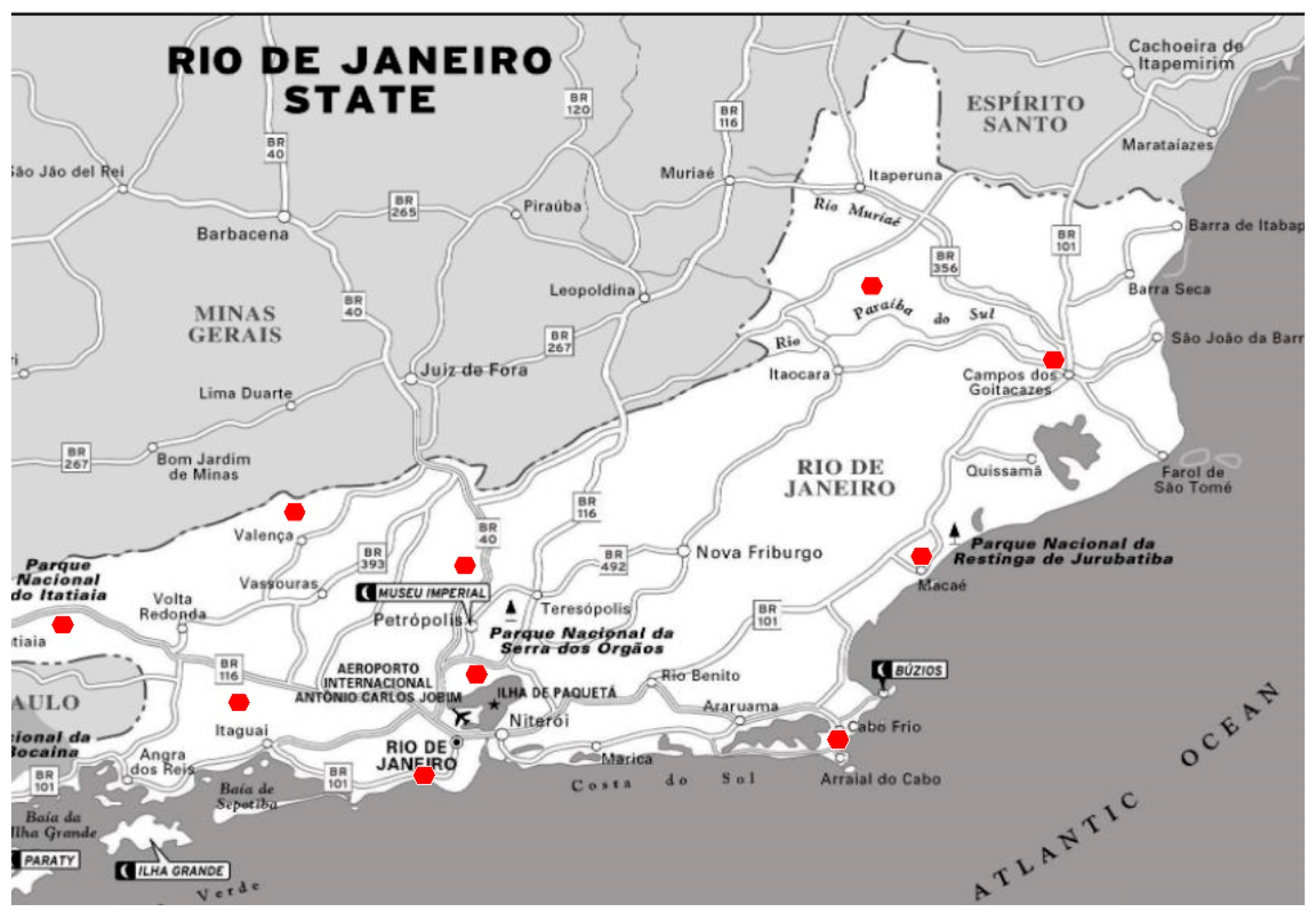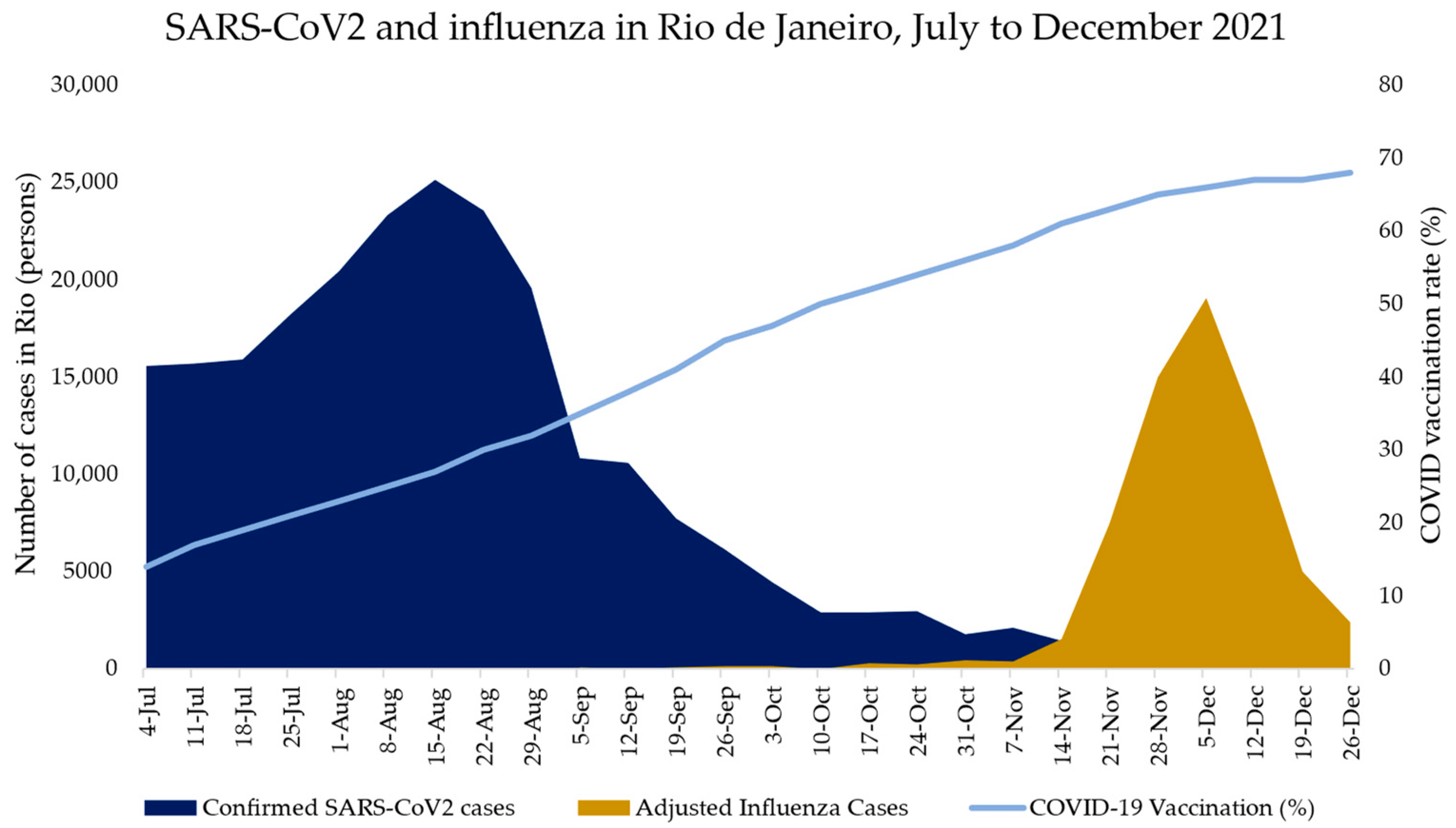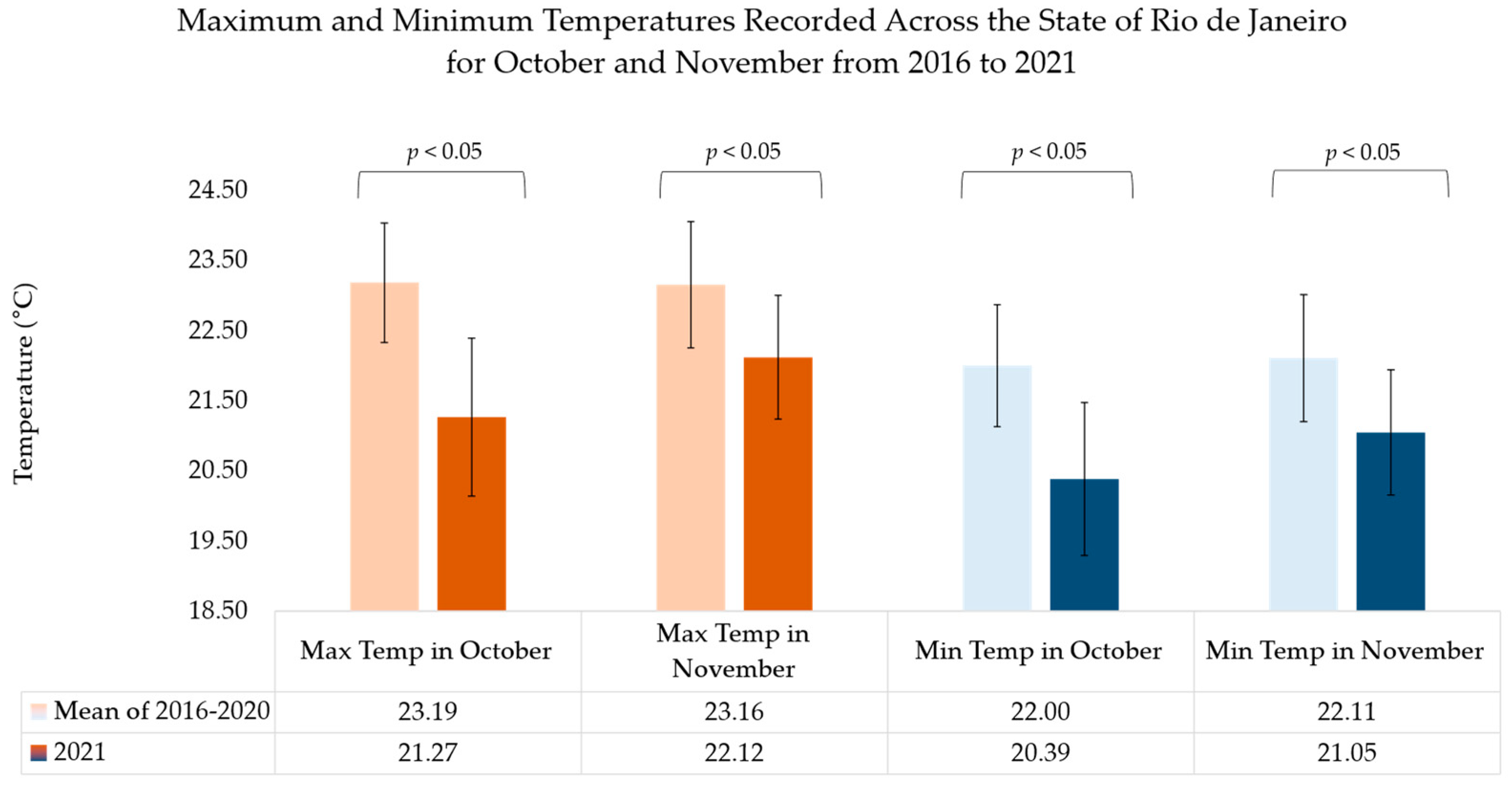Out-of-Season Influenza during a COVID-19 Void in the State of Rio de Janeiro, Brazil: Temperature Matters
Abstract
:1. Introduction
2. Materials and Methods
2.1. Calculation of Weekly SARS-CoV-2 Case Numbers
2.2. Calculation of Weekly Influenza Case Numbers
2.3. SARS-CoV-2 Immunization Coverage
2.4. Influenza Immunization Coverage
2.5. Association between Out-of-Season Influenza Outbreak and Climatic Variations
3. Results
4. Discussion
5. Conclusions
Author Contributions
Funding
Institutional Review Board Statement
Informed Consent Statement
Data Availability Statement
Conflicts of Interest
References
- Machado, C.J.; Pereira, C.C.D.A.; Viana, B.D.M.; Oliveira, G.L.; Melo, D.C.; Carvalho, J.F.M.G.D.; Moraes, F.L.D.; Moraes, E.N.D. Estimates of the impact of COVID-19 on mortality of institutionalized elderly in Brazil. Ciên. Saúde Coletiva 2020, 25, 3437–3444. [Google Scholar] [CrossRef] [PubMed]
- COVID-19 in Rio de Janeiro—Data by Event and Confirmation Date. Available online: http://sistemas.saude.rj.gov.br/tabnetbd/dhx.exe?covid19/tf_evento_divulgacao.def (accessed on 2 March 2022).
- Naik, P.A.; Yavuz, M.; Qureshi, S.; Zu, J.; Townley, S. Modeling and analysis of COVID-19 epidemics with treatment in fractional derivatives using real data from Pakistan. Eur. Phys. J. Plus 2020, 135, 795. [Google Scholar] [CrossRef] [PubMed]
- Özköse, F.; Yavuz, M. Investigation of interactions between COVID-19 and diabetes with hereditary traits using real data: A case study in Turkey. Comput. Biol. Med. 2022, 141, 105044. [Google Scholar] [CrossRef] [PubMed]
- Rio Has an Increase in Influenza A and Calls the Population to Get Vaccinated. Available online: https://agenciabrasil.ebc.com.br/saude/noticia/2021-11/rio-tem-aumento-de-influenza-e-chama-populacao-para-se-vacinar (accessed on 14 March 2022).
- SIVEP—Influenza-Notifications of Severe Acute Respiratory Syndromes (SRAG)—Rio de Janeiro. Available online: http://sistemas.saude.rj.gov.br/tabnetbd/dhx.exe?sivep_gripe/sivep_gripe.def (accessed on 14 March 2022).
- Emergency Operations Center. COVID-19 Epidemiological Bulletin [In Portuguese]. Rio de Janeiro, Brazil. Available online: https://coronavirus.rio/wp-content/uploads/2022/04/Boletim-Epidemiologico-COE-COVID-Rio-23-04.22_compressed-1.pdf (accessed on 28 April 2022).
- U.S. Influenza Surveillance: Purpose and Methods. Available online: https://www.cdc.gov/flu/weekly/overview.htm (accessed on 24 March 2022).
- Ministry of Health Health Information. Available online: http://tabnet.datasus.gov.br/cgi/dhdat.exe?bd_pni/dpnibr.def (accessed on 14 March 2022).
- Recommended Composition of Influenza Virus Vaccines for Use in the 2022 Southern Hemisphere Influenza Season. Available online: https://www.who.int/publications/m/item/recommended-composition-of-influenza-virus-vaccines-for-use-in-the-2022-southern-hemisphere-influenza-season (accessed on 14 March 2022).
- Weather Forecast. Available online: https://portal.inmet.gov.br/ (accessed on 20 March 2022).
- Influenza-Epidemiological Report—2018. Secretary of Ministry of Health. Monitoring until Epidemiological Week 14 of 2018. Available online: http://www.riocomsaude.rj.gov.br/Publico/MostrarArquivo.aspx?C=sUxSCWcPPuw%3d (accessed on 27 April 2022).
- Influenza-Epidemiological Report—2017. Secretary of Ministry of Health. Monitoring until Epidemiological Week 36 of 2017. Available online: http://www.riocomsaude.rj.gov.br/Publico/MostrarArquivo.aspx?C=PASmxOIIGbA%3d (accessed on 27 April 2022).
- Influenza-Epidemiological Report—2016. Secretary of Ministry of Health. Monitoring until Epidemiological Week 47 of 2016. Available online: http://www.riocomsaude.rj.gov.br/Publico/MostrarArquivo.aspx?C=VrhTa4sUF3U%3d (accessed on 27 April 2022).
- SIPNI-National Immunization Program Information System. Available online: http://sipni-gestao.datasus.gov.br/si-pni-web/faces/relatorio/consolidado/coberturaVacinalCampanhaInfluenza.jsf (accessed on 27 April 2022).
- World Health Organization. Recommended Composition of Influenza Virus Vaccines for Use in the 2016–2021 Southern Hemisphere Influenza Season. Available online: https://www.gisaid.org/resources/human-influenza-vaccine-composition/ (accessed on 27 April 2022).
- Crépey, P.; Boiron, L.; Araujo, R.R.; Lopez, J.G.; Petitjean, A.; de Albuquerque Luna, E.J. Impact of quadrivalent influenza vaccines in Brazil: A cost-effectiveness analysis using an influenza transmission model. BMC Public Health 2020, 20, 1374. [Google Scholar] [CrossRef] [PubMed]
- Influenza Vaccines in Brazil in 2019. Available online: https://sbim.org.br/images/files/notas-tecnicas/nota-tecnica-influenza-v2-190318.pdf (accessed on 28 April 2022).
- Epidemiological Situation of Influenza in the Municipality of São José do Rio Preto 2019. Available online: https://saude.riopreto.sp.gov.br/transparencia/arqu/boleepid/2019/boletins_epidemiologico_influenza_2019.pdf (accessed on 28 April 2022).
- SRAG 2019—Severe Acute Respiratory Syndrome Database. Available online: https://d26692udehoye.cloudfront.net/SRAG/2019/INFLUD19.csv (accessed on 28 April 2022).
- SRAG 2013–2018—Severe Acute Respiratory Syndrome Database. Available online: https://opendatasus.saude.gov.br/dataset/srag-2013-2018 (accessed on 28 April 2022).
- Weather and Climate in Rio de Janeiro in August. Available online: https://pt.climate-data.org/america-do-sul/brasil/rio-de-janeiro/rio-de-janeiro-853/t/agosto-8/ (accessed on 25 April 2022).
- Olsen, S.J.; Azziz-Baumgartner, E.; Budd, A.P.; Brammer, L.; Sullivan, S.; Pineda, R.F.; Cohen, C.; Fry, A.M. Decreased influenza activity during the COVID-19 pandemic—United States, Australia, Chile, and South Africa. MMWR Morb. Mortal Wkly. Rep. 2020, 69, 1305–1309. [Google Scholar] [CrossRef]
- Akhtar, Z.; Chowdhury, F.; Rahman, M.; Ghosh, P.K.; Ahmmed, M.K.; Islam, M.A.; Mott, J.A.; Davis, W. Seasonal influenza during the COVID-19 pandemic in Bangladesh. PLoS ONE 2021, 16, e0255646. [Google Scholar] [CrossRef] [PubMed]
- Di Mattia, G.; Nenna, R.; Mancino, E.; Rizzo, V.; Pierangeli, A.; Villani, A.; Midulla, F. During the COVID-19 pandemic where has respiratory syncytial virus gone? Pediatr. Pulmonol. 2021, 56, 3106–3109. [Google Scholar] [CrossRef] [PubMed]
- Di Mattia, G.; Nenna, R.; Mancino, E.; Rizzo, V.; Pierangeli, A.; Villani, A.; Midulla, F. Influenza lineage extinction during the COVID-19 pandemic? Nat. Rev. 2021, 19, 741–742. [Google Scholar]
- Zheng, Z.; Pitzer, V.E.; Shapiro, E.D.; Bont, L.J.; Weinberger, D.M. Estimation of the Timing and Intensity of Reemergence of Respiratory Syncytial Virus Following the COVID-19 Pandemic in the US. JAMA Netw. Open 2021, 4, e2141779. [Google Scholar] [CrossRef] [PubMed]
- Agha, R.; Avner, J. Delayed Seasonal RSV Surge Observed during the COVID-19 Pandemic. Pediatrics 2021, 148, e2021052089. [Google Scholar] [CrossRef]
- Saravanos, G.L.; Hu, N.; Homaira, N.; Muscatello, D.J.; Jaffe, A.; Bartlett, A.W.; Wood, N.J.; Rawlinson, W.; Kesson, A.; Lingam, R.; et al. RSV Epidemiology in Australia before and during COVID-19. Pediatrics 2022, 149, e2021053537. [Google Scholar] [CrossRef] [PubMed]
- Ujiie, M.; Tsuzuki, S.; Nakamoto, T.; Iwamoto, N. Resurgence of Respiratory Syncytial Virus Infections during COVID-19 Pandemic. Emerg. Infect. Dis. 2021, 27, 2969–2970. [Google Scholar] [CrossRef] [PubMed]
- Umunnakwe, C.N.; Makatini, Z.N.; Maphoto, R.; Tempelman, H.A. Sharp increase in influenza A infections in Limpopo: A call for increased influenza vaccinations. S. Afr. Med. J. 2022, 112, 13508. [Google Scholar] [CrossRef] [PubMed]
- Alonso, W.J.; Viboud, C.; Simonsen, L.; Hirano, E.W.; Daufenbach, L.Z.; Miller, M.A. Seasonality of influenza in Brazil: A traveling wave from the Amazon to the subtropics. Am. J. Epidemiol. 2007, 165, 1434–1442. [Google Scholar] [CrossRef] [PubMed]
- Moriyama, M.; Hugentobler, W.J.; Iwasaki, A. Seasonality of respiratory viral infections. Annu. Rev. Virol. 2020, 7, 83–101. [Google Scholar] [CrossRef] [PubMed]
- Schweizer, C.; Edwards, R.D.; Bayer-Oglesby, L.; Gauderman, W.J.; Ilacqua, V.; Juhani Jantunen, M.; Lai, H.K.; Nieuwenhuijsen, M.; Künzli, N. Indoor time–microenvironment–activity patterns in seven regions of Europe. J. Expo. Sci. Environ. Epidemiol. 2007, 17, 170–181. [Google Scholar] [CrossRef] [Green Version]
- Klepeis, N.E.; Nelson, W.C.; Ott, W.R.; Robinson, J.P.; Tsang, A.M.; Switzer, P.; Behar, J.V.; Hern, S.C.; Engelmann, W.H. The National Human Activity Pattern Survey (NHAPS): A resource for assessing exposure to environmental pollutants. J. Expo. Sci. Environ. Epidemiol. 2001, 11, 231–252. [Google Scholar] [CrossRef] [Green Version]
- Neumann, G.; Kawaoka, Y. Seasonality of influenza and other respiratory viruses. EMBO Mol. Med. 2022, 14, e15352. [Google Scholar] [CrossRef]



| Year | Hospitalizations | Cases * | Month(s) with the Highest Number of Cases (S6–8) | Circulating Strain (S1–3,8) | Trivalent Vaccine Strains (S5) | Vaccination Coverage (S4) |
|---|---|---|---|---|---|---|
| 2016 | 2484 | 191,076 | May–June | A/(H1N1)pdm09 ** | A/California/(H1N1) pdm09 A/Hong Kong/(H3N2) B/Brisbane | 91% |
| 2017 | 1155 | 88,846 | May–June | A/(H3N2) | A/Michigan/(H1N1)pdm09 A/Hong Kong/(H3N2) B/Brisbane | 85% |
| 2018 | 1898 | 146,000 | May–June | A/(H1N1)pdm09 | A/Michigan/(H1N1)pdm09 A/Singapore/(H3N2) B/Phuket | 78% |
| 2019 | 2394 | 184,154 | May–June | A/(H1N1)pdm09 | A/Michigan/(H1N1)pdm09 A/Switzerland/(H3N2) B/Victoria | 93% |
| 2020 | 0 | NA | NA | NA | A/Brisbane/(H1N1)pdm09 A/South Australia/(H3N2) B/Washington | 91% |
| 2021 | 885 | 68,077 | November | A/Darwin (H3N2) | A/Victoria/(H1N1)pdm09 A/Hong Kong/(H3N2) B/Victoria | 58% |
| Year | Minimum (°C) | Mean (°C) | Maximum (°C) | ||||
|---|---|---|---|---|---|---|---|
| October Only | November Only | Whole Year | Whole Year | October Only | November Only | Whole Year | |
| 2016 | 21.17 (20.2–22.14) | 22.04 (21.12–22.96) | 21.62 (20.58–22.65) | 22.16 (21.13–23.2) | 22.42 (21.51–23.34) | 23.11 (22.22–24.01) | 22.74 (21.71–23.77) |
| 2017 | 22.33 (21.61–23.06) | 22.01 (21.15–22.87) | 21.58 (20.68–22.47) | 22.15 (21.27–23.04) | 23.77 (23.08–24.46) | 23.09 (22.23–23.95) | 22.76 (21.88–23.65) |
| 2018 | 21.74 (20.8–22.67) | 22.34 (21.36–23.32) | 21.07 (20–22.13) | 21.71 (20.69–22.73) | 22.67 (21.72–23.61) | 23.35 (22.36–24.33) | 22.15 (21.08–23.22) |
| 2019 | 22.42 (21.54–23.31) | 22.12 (21.23–23.01) | 22.1 (21.18–23.03) | 22.67 (21.74–23.6) | 23.57 (22.69–24.45) | 23.11 (22.23–24) | 23.27 (22.34–24.2) |
| 2020 | 23.2 23.07–23.33) | 22.81 (22.62–23) | 22.14 (21.18–23.03) | 22.69 (21.74–23.6) | 24.33 (24.21–24.45) | 23.91 (23.76–24.05) | 23.27 (22.57–23.97) |
| 2021 | 20.39 (19.3–21.48) | 21.05 (20.16–21.94) | 21.11 (20.19–22.04) | 21.68 (20.76–22.6) | 21.27 (20.14–22.39) | 22.12 (21.24–23.01) | 22.28 (22.57–23.97) |
Publisher’s Note: MDPI stays neutral with regard to jurisdictional claims in published maps and institutional affiliations. |
© 2022 by the authors. Licensee MDPI, Basel, Switzerland. This article is an open access article distributed under the terms and conditions of the Creative Commons Attribution (CC BY) license (https://creativecommons.org/licenses/by/4.0/).
Share and Cite
Nott, R.; Fuller, T.L.; Brasil, P.; Nielsen-Saines, K. Out-of-Season Influenza during a COVID-19 Void in the State of Rio de Janeiro, Brazil: Temperature Matters. Vaccines 2022, 10, 821. https://doi.org/10.3390/vaccines10050821
Nott R, Fuller TL, Brasil P, Nielsen-Saines K. Out-of-Season Influenza during a COVID-19 Void in the State of Rio de Janeiro, Brazil: Temperature Matters. Vaccines. 2022; 10(5):821. https://doi.org/10.3390/vaccines10050821
Chicago/Turabian StyleNott, Rohini, Trevon L. Fuller, Patrícia Brasil, and Karin Nielsen-Saines. 2022. "Out-of-Season Influenza during a COVID-19 Void in the State of Rio de Janeiro, Brazil: Temperature Matters" Vaccines 10, no. 5: 821. https://doi.org/10.3390/vaccines10050821
APA StyleNott, R., Fuller, T. L., Brasil, P., & Nielsen-Saines, K. (2022). Out-of-Season Influenza during a COVID-19 Void in the State of Rio de Janeiro, Brazil: Temperature Matters. Vaccines, 10(5), 821. https://doi.org/10.3390/vaccines10050821






